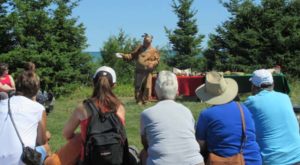Inspirational and educational Medicine Walk at Fort St. Joseph National Historic Site

By Rick Garrick
RICHARDS LANDING—Leo Binda of Garden River First Nation enjoyed sharing his knowledge about traditional medicines at the Fort St. Joseph National Historic Site Medicine Walk on August 7, 2016.
“A lot of the people were expecting just to walk around looking at plants, but I like talking about the spiritual part of it,” Binda says. “Sometimes [when] we show them what we know, a lot of people will tend to go out and look for it without understanding the plants.”
Binda also made cedar tea with balsam and spruce for the visitors to sample during the Medicine Walk.
“They all tried it and liked it,” Binda says. “We talked about [that] when the first Europeans came over the Native people gave them cedar tea for scurvy.”
Binda shared his knowledge with two groups of visitors during the Medicine Walk, which was held during the afternoon at Fort St. Joseph National Historic Site. The site is located about 75 kilometers south-east of Sault Ste. Marie on the southern tip of St. Joseph Island.
“I’m still learning myself, picking up things here and there with different people,” Binda says. “We [talked about] wintergreen and a few other things that are familiar and easier to identify.”
Binda noted that different families used to go out on the land to harvest medicines in the past.
“They would just bring [the medicines] back together after and trade,” Binda says. “They would just share it all.”
Fran Robb, heritage presenter with Fort St. Joseph National Heritage Site, says the Medicine Walk was “completely sold out” and “a hit with everyone.”
“This Medicine Walk is the first paragraph of a long cultural understanding, a story yet to be told and still unfolding,” Robb says in an e-mail message. “This first Medicine Walk was a complete sell out with a three-page waiting list, which shows that there is an audience that wishes to learn.”
A group of Métis re-enactors also shared information with the visitors during the Medicine Walk.
“People were very much interested in what we were presenting,” says Jean-Marie Wissell, a Métis re-enactor with Fort St. Joseph Nations Heritage Site. “My character was talking about the clash between the Métis being a Christian and also following the Native spirituality respecting Mother Earth and getting medicines from the land.”
Wissell says his table featured an open bible, as it was Sunday, and his Native spiritual items.
“I was explaining that if the Métis was in the fort, he would attend the Anglican Church, and if he was travelling to Montreal he would attend the Catholic Church,” Wissell says. “But out in the bush without the church, he would have been married to a Native wife and he would follow the Native ways.”
Yvonne Jensen, President of the North Channel Métis Council and a visitor, enjoyed the Medicine Walk, noting the First Nation’s part of the Medicine Walk which included a fire, cedar tea, drummers and a drum blessing ceremony.
“The guy [Binda] that did all the medicine talk about all [of] the natural [plants] was really good — he knew what he was talking about,” Jensen says. “He passed around a lot of the medicines that he had. And he let us try some of them.”
Jensen says the Métis part of the Medicine Walk included Métis dancing and music, Métis preparations for travelling in their canoes and the traditional medicines they used.
“He [Wissell] pretty much had the same medicines as the First Nations had,” Jensen says. “So that was pretty interesting that the same stuff that the Métis used is what the First Nations used also.”


